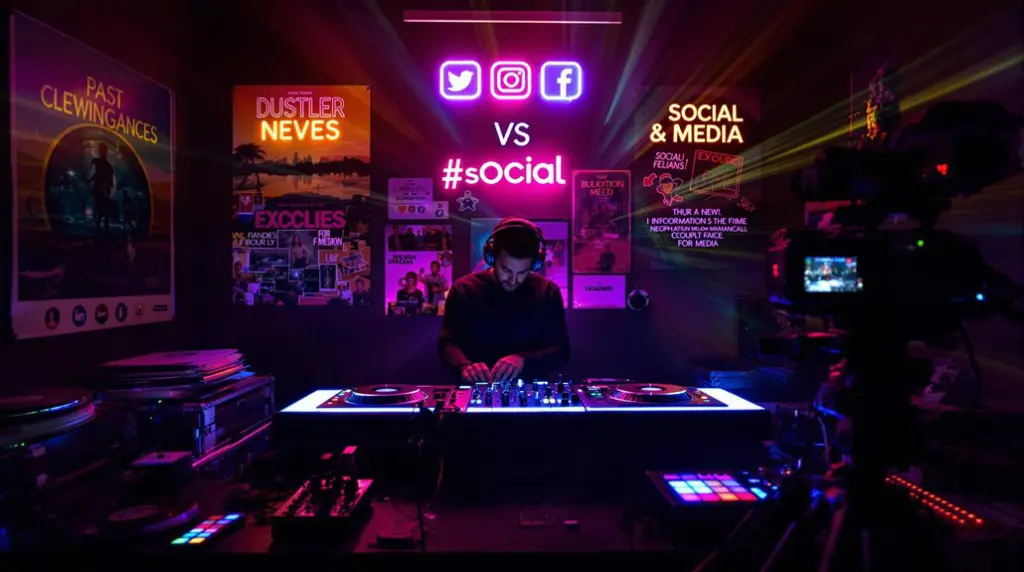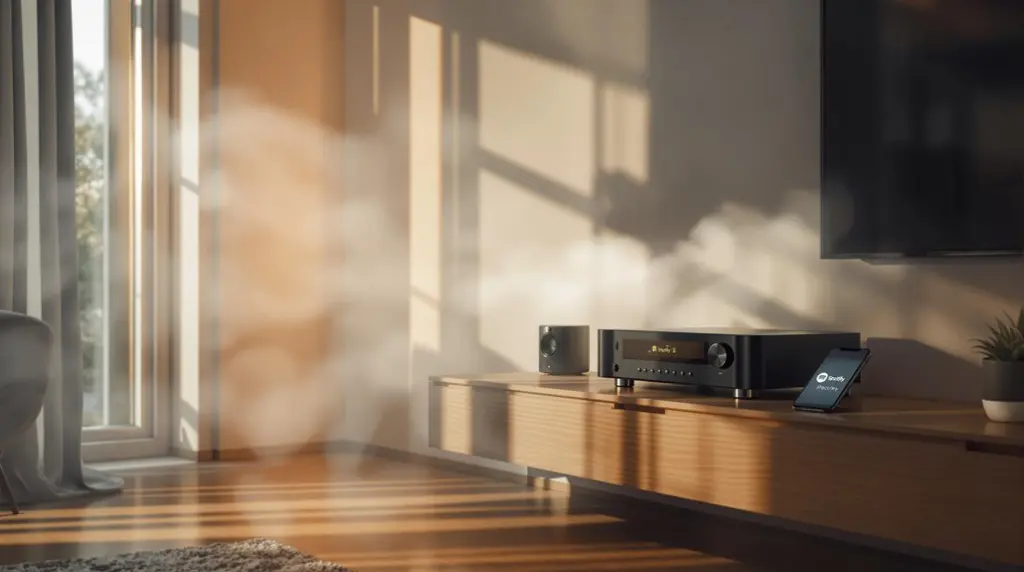To create original beats for DJ sets, mastering the foundations of beat making is essential. Start with key elements like bass lines, kick drums, and percussive sounds to build a solid rhythmic structure. Utilize Digital Audio Workstations (DAWs) like Ableton Live or Logic Pro X for advanced sound design and MIDI controllers for expressive performance. Incorporate rhythmic variations to keep listeners engaged and explore genre-blending for a unique sound. Fundamental mixing and mastering techniques such as EQ, compression, and volume balance are important for a polished track. For a deeper understanding of enhancing creativity and promoting your tracks, continue.
Key Takeaways
- Choose a suitable DAW like Ableton Live or FL Studio to streamline the beat-making workflow.
- Utilize MIDI controllers like the Akai MPK Mini MK3 for expressive performance and efficient beat production.
- Balance EQ and apply compression to enhance frequency clarity and manage dynamic range.
- Experiment with genre blending and emotional storytelling to foster creativity and innovative sounds.
- Promote beats on platforms like Beatstars and engage with audiences on social media for wider visibility.
Foundations of Beat Making
Understanding the foundations of beat making is essential for any aspiring music producer, as it sets the stage for crafting compelling rhythms and grooves. Central to this process are key elements such as bass lines, kick drums, and percussive components, all of which contribute to the rhythmic foundation of a track.
Bass line development is particularly important, as it forms the backbone of the groove, anchoring the rhythm and providing depth. A well-crafted bass line should complement the kick drum, creating a cohesive low-end that listeners can feel. Additionally, understanding song structure improves mix cohesion and emotional engagement, which can enhance the overall flow and impact of your beats.
Rhythmic variation is another significant aspect of beat making. While repetition is necessary to establish a memorable groove, subtle variations are important to maintain listener interest and add dynamic complexity. This can be achieved through the use of different patterns, syncopation, or the strategic placement of percussive elements.
Understanding song structure is also important, as the organization of sections like the intro, verse, chorus, and bridge will dictate how these rhythmic elements evolve throughout the track.
Essential Tools and Technology
To achieve professional-quality beats, choosing the right Digital Audio Workstation (DAW) such as Ableton Live, FL Studio, or Logic Pro X is paramount.
Complementing your DAW with top-tier MIDI controllers like keyboards and drum pads can streamline your workflow and enhance expressive performance.
Additionally, leveraging extensive sample libraries offers a wealth of royalty-free sounds to infuse originality and depth into your creations.
In particular, utilizing EQ can creatively enhance sonic quality, transforming good beats into great ones.
Choosing the Right DAW
Selecting the right Digital Audio Workstation (DAW) can make or break the beat-making process, as it serves as the backbone of your production workflow. DAW customization options and DAW workflow efficiency are vital factors to take into account when choosing the right software.
Popular choices like Ableton Live, FL Studio, and Logic Pro X each offer unique features that cater to different styles of music production. Ableton Live is renowned for its live performance capabilities and intuitive session view. FL Studio boasts a user-friendly interface ideal for beginners, while Logic Pro X provides an extensive suite of tools suited for intricate sound design and advanced production.
Each DAW provides built-in instruments and effects, allowing DJs and producers to craft unique sounds without needing additional software. This capability is essential for achieving a high level of creative vision and sound design.
Furthermore, the choice of DAW can greatly influence your workflow and creativity, making it vital to explore various options meticulously. Utilize learning resources such as manuals, online tutorials, and community forums to master your chosen DAW and enhance your beat-making skills.
Ultimately, selecting the right DAW is a personal decision that should align with your production goals and artistic preferences.
Top MIDI Controllers
For any DJ or music producer aiming to improve their craft, incorporating a high-quality MIDI controller into their setup is paramount.
These essential tools allow for the real-time manipulation of virtual instruments and drum sounds, greatly enhancing live performance capabilities. When discussing MIDI controller features and controller brand comparisons, several standout models emerge.
- Native Instruments Komplete Kontrol S25: This controller boasts 25 velocity-sensitive keys, perfect for those with musical experience seeking a broader range for melodies and chords. It seamlessly integrates with Komplete software, making it a versatile choice for diverse musical styles.
- Akai MPK Mini MK3: Known for its portability and robust build, this controller includes drum pads, an arpeggiator, and assignable knobs, offering a thorough beat-making toolkit. Its compact design makes it ideal for DJs on the go.
- M-Audio Oxygen 25 IV: With a blend of 25 full-sized keys and eight velocity-sensitive drum pads, this controller is excellent for producing both intricate melodies and dynamic beats. Bundled software like Ableton Live Lite enhances its value.
- Novation Launchpad Pro: Especially favored in electronic and hip-hop music production, this controller’s grid of RGB pads supports intuitive beat-making and finger drumming techniques, allowing for creative expression.
These controllers not only raise a DJ’s performance but also streamline the beat-making process, making them indispensable in any professional setup.
Using Sample Libraries
When starting on the journey of beat-making, utilizing sample libraries becomes a cornerstone of both creativity and efficiency. Sample libraries offer a vast collection of sounds, including kick drums, snares, percussion, and melodic samples. These elements serve as the foundational building blocks for constructing original beats, allowing DJs to focus on their creative vision and sound design.
Effective sample selection is essential. Genre-specific sample packs can streamline the process, ensuring that the sounds fit seamlessly within particular musical styles. This not only enhances creativity but also improves efficiency, allowing DJs to craft their beats without the constant need for external sound sources. Additionally, many sample libraries include royalty-free sounds, ensuring DJs can integrate these elements into their sets without legal concerns.
Sound layering is another vital aspect facilitated by sample libraries. By stacking and manipulating different samples, DJs can create intricate and unique textures, adding depth to their tracks.
Tools like Soundtrap enhance this experience by offering a thorough library of loops and samples, enabling seamless exploration and integration into original compositions. A well-organized sample library greatly accelerates the beat-making process, letting DJs focus on creativity and arrangement rather than sound sourcing.
Enhancing Creativity
Enhancing creativity in beat making is pivotal for producing innovative and enchanting music that stands out in the competitive landscape of DJing. To achieve this, DJs must embrace genre experimentation and emotional storytelling, which can transform ordinary tracks into memorable sonic experiences.
By blending genres, DJs can break conventional boundaries and create unique beats. Using advanced tools like KOMPLETE 14 and AI production software enables the discovery of new sounds and textures, pushing the limits of traditional music production. Incorporating physical instruments and live recordings into electronic beats adds a layer of authenticity and depth, making tracks more engaging.
Additionally, leveraging software like Traktor Pro or VirtualDJ can provide advanced capabilities that enhance your creative process.
Here are four effective strategies to enhance creativity in beat making:
- Genre Experimentation: Merge different musical styles to create fresh, innovative sounds that captivate listeners.
- Emotional Storytelling: Set emotional goals and utilize mood boards with reference tracks to guide the creative direction and structure of your music.
- Utilize Advanced Tools: Leverage cutting-edge production software to explore new sonic possibilities and inspire new ideas.
- Continuous Exploration and Feedback: Regularly practice, explore new techniques, and engage with community forums for constructive feedback to refine and enhance your skills.
Mixing and Mastering Techniques
In the domain of mixing, precise application of EQ and compression is paramount to achieving a balanced and transparent sound.
Adjusting levels and employing EQ techniques helps to minimize frequency clashes, while compression tools enhance dynamic control and instrument separation.
Incorporating real-time effects manipulation can also raise the mix by allowing for instant adjustments and creative shifts.
Mastering, the final step, utilizes advanced software like Ozone to guarantee the mix adheres to loudness standards and sounds ideal across all playback systems.
EQ and Compression Application
Often regarded as the cornerstone of professional mixing, EQ and compression application are vital techniques that shape the sonic landscape of a track. Effective use of EQ is imperative for frequency balancing, enabling producers to enhance specific frequency ranges and guarantee clarity.
By applying a high-pass filter, unnecessary low frequencies can be removed from non-bass instruments, thereby allowing the kick drum and bassline to dominate the low-end spectrum without interference.
Compression, on the other hand, is essential for dynamic shaping. This technique helps manage the dynamic range, making quieter parts more audible and louder parts more controlled, which is particularly beneficial for balancing percussion and melodic elements.
Properly setting the attack and release times on a compressor can greatly influence the punch and presence of kick drums and snares.
Key steps to integrate EQ and compression effectively include:
- Identify frequency clashes: Use EQ to carve out space for each instrument, particularly between bass and kick drum.
- Apply high-pass filters: Remove low frequencies from non-bass elements to avoid muddiness.
- Set compression parameters: Adjust attack and release times to control dynamics without compromising the natural sound.
- Balance EQ and compression: Combine both techniques to enhance the overall sonic quality, ensuring each element remains distinct yet cohesive.
These strategies guarantee that your track is polished and professional, ready to captivate any audience.
Volume Balance Techniques
Achieving an ideal volume balance is a fundamental aspect of both mixing and mastering, guaranteeing that each element within a track is perceptible without overshadowing others. Effective level adjustments begin with precise volume fader manipulations to establish the prominence of individual tracks.
Implementing dynamic control through compression is essential; it stabilizes the dynamic range, assuring that quieter elements emerge while maintaining the vigor of louder sounds, thereby fostering a cohesive mix.
Frequency separation via equalization (EQ) is another critical technique. By carving out specific frequency ranges for each sound, producers can prevent frequency clashes, enhancing the clarity and definition of each element.
Stereo imaging, achieved through panning, further refines the mix by distributing sounds across the stereo field, creating a wider and more immersive soundstage. This technique guarantees that the mix doesn’t become congested in the center and maintains spatial balance.
Reference checking is indispensable; it involves evaluating the mix on various playback systems to guarantee that the volume balance is consistent across different environments. This step helps identify and rectify any discrepancies, assuring that the track maintains its intended impact regardless of the listening context.
Steps to Create a Beat
Setting the tempo and vibe of your beat serves as the essential first step in beat making, where determining the BPM is influenced by the genre and the emotional tone you aim to convey.
This foundational groove sets the stage for your entire composition, allowing for a cohesive and engaging beat structure.
- Create Drum Patterns: Utilize a sequencer or pre-made loops to craft drum patterns. Focus on kick, snare, and hi-hats to establish a solid rhythmic foundation. Experiment with rhythmic variation to keep the beat dynamic and interesting.
- Build Chord Progressions: Develop foundational chords that underpin the melody and bass. Chord progressions add a harmonic layer, enriching the overall soundscape and providing a base for melodic development.
- Incorporate a Melody: Craft a catchy melody that complements your drum patterns and bass line. Ascertain the melody is in the same key as the rest of your track to maintain musical cohesion and enhance listener engagement.
- Add Samples and Sound Effects: Continuously refine your beat by integrating samples and sound effects. Use everyday sounds or unique samples to add character and maintain listener interest, guaranteeing the composition remains fresh and engaging.
Promoting Your Beats
Promoting your beats effectively involves a strategic blend of technical expertise, creative vision, and an understanding of sound design. Utilizing platforms like Beatstars and Bandcamp can greatly enhance your beat marketing efforts, facilitating direct engagement with potential buyers and fans. These platforms allow you to showcase your work while providing valuable insights into listener preferences and trends.
Leveraging social media channels such as Instagram and TikTok is another powerful strategy. By sharing snippets of your beats and employing strategic hashtags, you can attract a wider audience and bolster audience engagement. Consistently posting new beats and updates on these platforms will help maintain engagement and encourage repeat listens, gradually building a loyal fan base.
Collaborating with emerging artists can also boost your visibility. Successful projects can lead to greater exposure and invaluable networking opportunities. Additionally, optimizing your online presence with SEO tactics guarantees that your beats are easily discoverable through search engines and streaming services.
| Platform | Purpose | Benefit |
|---|---|---|
| Beatstars | Selling beats | Direct engagement with buyers |
| Bandcamp | Promoting and selling | Insight into listener trends |
| Social media engagement | Wider audience reach | |
| TikTok | Short beat showcases | Audience attraction |
| SEO Tactics | Online visibility | Easier discovery of beats |
Frequently Asked Questions
How Do You Make an Original Beat?
To create an original beat, begin with beat composition by establishing a kick drum pattern, then engage in sound layering by adding percussion, melody, and bass. Utilize a DAW to refine your mix with techniques from sound design.
Can You Make Beats With a DJ Set?
Yes, DJs can create beats with a DJ set by utilizing rhythm techniques and live performance tools. By leveraging advanced sound design capabilities in DJ software and hardware, they can craft and manipulate original beats dynamically during their sets.
What Is the Thing That DJS Use to Make Beats?
To achieve beat production, DJs primarily utilize Digital Audio Workstations (DAWs) such as Ableton Live or FL Studio. These platforms, alongside MIDI controllers and high-quality music sampling libraries, enable DJs to execute their creative vision and sound design effectively.
What Is the Best Software to Make Beats?
The best software for beat production tools and music composition software includes Ableton Live, FL Studio, and Logic Pro X, offering technical expertise, creative vision, and advanced sound design capabilities essential for professional-grade beat-making.
Conclusion
In summary, mastering the art of beat making requires an extensive understanding of foundational principles, essential tools, and advanced techniques. By integrating creative vision with technical expertise in sound design, DJs can produce unique and compelling beats for their sets. The process involves meticulous attention to mixing and mastering, ensuring high-quality output. Ultimately, effective promotion strategies are vital for gaining recognition and establishing a presence in the competitive music industry.




